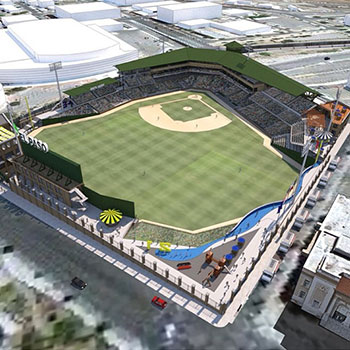No matter where you live in the United States, you’ve seen a version of the headline, “City Hall Gives Way in Stadium Deal.” In El Paso, Texas, they take those words literally.
As of early this week, city government personnel had already decamped for other ground, as what is now the former City Hall (along with a nearby children’s science museum) faces demolition within the next two weeks to make way for a new Triple-A baseball stadium downtown that will be finished in time for Opening Day 2014.
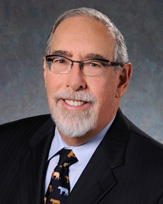
The dramatic replacement of a government facility with a modern ballpark is just part of an overall downtown redevelopment plan that received overwhelming voter support last November, when some 80 percent of voters approved a $473-million “quality of life” bond measure, part of a $473-million overall package that will back 85 different projects throughout the city, including a new children’s museum, parks and an arena. Thus it’s no surprise that Forbes this month named El Paso’s one of “15 U.S. cities’ emerging downtowns.”
The city hall building, located near the convention center and originally designed as a hotel, was always out of place, as most other government offices are in another part of town. But the decision was a difficult one in a difficult year for outgoing two-term mayor John Cook, who told El Paso Inc. earlier this week that he’s “officing out of my F-150” pickup truck. Last September, coming off a recall fight stemming from his support for extending healthcare benefits to same-sex domestic partners of city employees, Cook issued a statement about his ballpark dilemma after the city council had approved going ahead with an agreement with Mountain Star Sports Group:
“I have given this issue much thought and soul searching and have come to the conclusion that it is not in the best interest of the City of El Paso for the Mayor to use his veto power,” said Cook, who initially had intended to do so. “Based upon the information I have been provided by the city manager and the investor group, I believe any delay might cause us to lose this opportunity.”
Initially troubled by lack of voter approval, Cook said he was convinced by City Manager Joyce Wilson and her staff “that the ballpark is really an economic development project and deserves to be treated as such. The City of El Paso regularly approves economic development projects without voter approval.”
As for the demolition of City Hall, Cook said, “After researching possible sites, an alternate site for the baseball stadium could have been the buildings south of the Convention Center all the way to Paisano Drive which includes 38 parcels of land owned by 22 different owners for a total land value of $25 million. The selection of this site would have created the need to use eminent domain and might require the City to incur expensive attorney fees and court costs. It would have also slowed down the process and possibly kill the idea for a ballpark.
“Additionally,” he continued, “the condition of City Hall and the price tag of $30 million to renovate would not be an overall benefit to the City. The $13-million appraised value of City Hall is comparable with the research that I did on other large downtown properties that include Wells Fargo, Chase and El Paso Electric buildings which were sold in the last five years and were appraised within the range of $12-$15 million. This assessment supports the argument to use the City Hall site.”
Two days previous, the city council approved the signing of a lease between the city and MountainStar, which comprises longtime baseball leader Alan Ledford (president) and MountainStar founders Paul Foster, Alejandra de la Vega Foster, Woody Hunt and Josh Hunt. Foster is the billionaire executive chairman of Western Refining. The Hunts are father and son, and part of the El Paso-based national real estate powerhouse Hunt Companies, which has made its fortune over decades on innovative real estate development, especially in the multifamily and military sectors.
The team acquisition and stadium deal was “a long-term part of both my family and the Foster family trying to improve El Paso,” says Josh Hunt in an interview, “improve its quality of life and its competitiveness, and make it more attractive to outsiders and to people already living here.”
The stadium development agreement includes a non-relocation provision stating that the team will not relocate for 25 years following the start of the first season, which should take place on Opening Day 2014. Helping the city pay for the project will be a two-percent increase in the hotel occupancy tax, part of the package approved by voters in November.
Timing Is Everything
The team acquisition was finalized on Oct. 11, 2012. MountainStar was represented in the deal by real estate and development attorneys Paul Jacobs and Shane Orr of Husch Blackwell, who also negotiated the agreements with the city to develop and lease the new ballpark. Jacobs was the driving force behind Denver’s successful bid to attract a Major League Baseball expansion franchise in 1990. He represented the Colorado Rockies in the development of Coors Field, and served as executive vice president and general counsel of the Rockies from the award of the franchise in 1991 through January 1995.
Jacobs also represented the City of San Diego in connection with the development of Petco Park, home of the San Diego Padres, and its surrounding ballpark district. That district’s blooming has been recognized as one of the most successful public-private partnerships in the nation. As it happens, the team coming to El Paso is the Padres Triple-A affiliate, which will move from Tucson, Ariz.
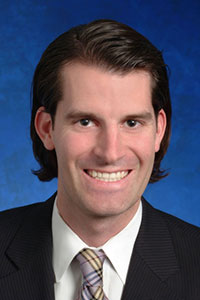
In an interview, Jacobs says using sports venues as catalysts for downtown redevelopment is in vogue for a reason.
“It works,” he says. “In Denver, the stadium and getting baseball here were the focus.” Once the facility was built, expansion of the city’s Lower Downtown Historic District (LODO) was left to market forces and individual developers, who have come through in spades. In San Diego, he says, a full-scale plan was in place from the beginning.
“They actually blew up 32 blocks,” he says, “and a real estate affiliate of the Padres was responsible for a certain amount of development in the deal — so many hotel rooms, commercial space, residential units. The catalyst was there right away. You had a plan, you knew where it was going to go, you kicked it off. There was over $1 billion in new development by opening day in 2004. That whole area just took off because there was a definitive plan, with somebody responsible.”
Not that it was easy. Jacobs says it took seven years of his life, in part because getting anything done in California means multiplying the timeline by four or five, he says. Seventeen lawsuits didn’t help, challenging everything from the property condemnation to bond passage technicalities. “In fact, the stadium was literally coming out of the ground, and we had to stop because somebody challenged the constitutionality of it,” he says.
The initial process in El Paso is a dream by comparison, moving along what Jacobs calls “a pretty quick timeline” that featured a letter of intent on the team acquisition signed in May 2012. Then again, he notes, “when the city is actually the one building the ballpark, yes, the process is easy.”
Bob Cook (no relation to the mayor) is president of the El Paso Regional Economic Development Corporation, which is in the process of joining forces with Paso del Norte Group to establish the Borderplex Binational Economic Alliance, comprising public policy and project attraction efforts in El Paso, Las Cruces, N.M., and Juarez, Mexico. Josh Hunt, a member of the Paso del Norte Group, puts it this way: “We’re not one community, but three communities in one region. And we’re going to go compete globally as a region.”
Cook says the ownership group provided the impetus for the new ballpark, but local leaders including him had been trying for the past two and a half years to convince the Pacific Coast League to select El Paso as a member.
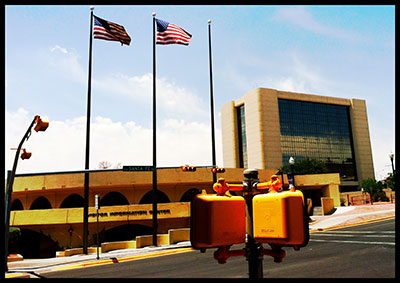
The former El Paso City Hall (left) was located in the convention center and entertainment district of downtown, and was originally designed to be a hotel.
Photo courtesy of El Paso Convention and Tourism Bureau
“We made a run at the Pacific Coast League a couple years ago, and the Padres Triple-A franchise, previously in Portland, Oregon, was looking for a new home,” he says. The ownership group selected a location in Escondido, in the San Diego area, but the deal fell through when California Gov. Jerry Brown abolished redevelopment agencies, which the new $50-million stadium in Escondido depended on. Ironically, says Josh Hunt, the team owner the El Paso group had originally lost out to two years ago (Padres minority owner Jeff Moorad) “was who we ended up buying the team from.”
Thus El Paso’s window of opportunity was open again last spring, even as Tucson lingered as a temporary home. Boise, Idaho, was also reportedly in the hunt for the franchise.
“My team and ownership were in front of the Pacific Coast League executive committee in late June,” says Bob Cook. “The owner and league leadership worked very quickly. It was breathtaking to watch how they got the deal done.”
The city hall site was “really the only option the city had to provide enough land” and to do so in a rapid fashion. Cook describes the city hall structure as having “that early ‘70s hotel kind of feel, with a lot of reflective glass. It was not intended to be a government building.”
Hunt says consideration of repurposing the City Hall site goes back to the city council’s “2020 Downtown” plan hatched in 2005, when an arena or convention hotel were among the possibilities. He says the 600 city employees who used to get in their cars to go eat lunch somewhere will now be in a government district where they can walk instead.
Cook’s team compared El Paso to all the existing Pacific Coast League cities and some International League minor league cities on the Eastern Seaboard on between 30 and 40 indicators.
Asked about exercising caution in overselling the economic potential of a baseball venue, Cook says, “The data I’ve looked at indicates it depends on the way you develop the stadium, plus the way it’s designed and can accommodate more than just baseball events. When you look within a five-mile radius of those [other cities’] stadiums, you see a fairly significant increase in property values. The data showed early on that downtown was the best location for El Paso, and looking at the experience of other communities, the design for El Paso will be successful. The stadium will be visible from I-10, visible from Mexico and visible from New Mexico. It will be at a juncture where you can pull fans from all directions.”
The Market and the Marketing
Indeed, Mexico sits just 10 blocks away from the stadium site. But even as economic development leaders have moved to join forces across the national border, the demographic studies for the baseball project were confined to U.S. territory. So the prospects for the team’s success are even more promising than the official numbers indicate when the 1.7 million people in El Paso’s sister city of Juarez are factored into the picture. The city is home to 220,000 manufacturing jobs and operations from about 55 FORTUNE 500 companies.
“They provide a lot of engineering jobs for Mexican nationals with really good disposable income,” says Cook. Prior to the recession, Cook’s team estimated $1.4 billion a year in annual retail sales to Mexican nationals took place in El Paso.
“On a daily basis we see about 28,000 private vehicles crossing from Mexico to El Paso,” he says, “and another 17,000 pedestrians crossing through downtown.”
C. F. Jordan Construction and Hunt Construction Group (no relation to Hunt Companies) will serve as construction manager at-risk under a $40-million contract awarded in January. Earlier in the winter, the El Paso City Council approved a $3-million contract with Kansas City, Mo.-based architecture and design firm Populous for the ballpark, which will feature an open-air design with natural turf, 7,000-8,000 seats, 20 to 30 luxury boxes, and 250 to 500 club seats. Populous has designed 48 minor league ballparks, including the 2012 Ballpark of the Year, Blue Wahoos Park in Pensacola, Fla. Mike Sabatini, principal and senior architect at Populous, was senior project designer for the New York Mets’ Citi Field. He says the stadium will bring even more energy to an area already envisioned to be an entertainment district, and which has already made strides toward that end.
“It brings another level of personality,” he says, while also adhering to the requirement to fit into the architectural themes of the immediate area. One gesture toward that goal is the removal and reuse of a large clock in City Hall that will be part of the stadium’s clock tower. The personality of the area climate is another special concern: The design is in an “L” shape, and features 24 rows on one side and only 12 on another in order to keep more people shaded and cool. But the most unique facet of the project, he says, is the tiny parcel involved.
“It’s a small site, and you’re trying to drop an eight-story building down into it,” he says. “It’s a tight site, and we’re going vertical, but when you have 8,300 seats, you don’t have an upper deck.”
One challenge is the nearby active railroad line from Union Pacific that runs 24/7. He says the entire train schedule has to be coordinated with the demolition and construction schedule. Special trenches dug just outside City Hall’s walls will help alleviate UP’s concern about vibrations from the eight-second implosion of City Hall. Sabatini says city officials have been great to work with.
“They’ve been open to suggestions, and very accommodating to ideas,” he says of the team led by City Engineer Alan Shubert. “I just recently met with the code officials. They’re reasonable. To me, they want this thing to happen, and they are behind it. They passed the bond … that kind of quality of life initiative filters through everyone involved with the city, and even UP.”
Will They Come?
Whether a stadium will revive a downtown is always open to debate. But the consensus of statistics and educated observers tilts favorably for El Paso.
Sabatini says his team visited comparable communities such as Tulsa, Okla.; Huntington, W. Va., and Dayton, Ohio, with ownership and city officials to see just what had transpired.
“They knew how long since Tulsa had been constructed [it opened in 2010]. They can see what has happened,” he says. “You can interpolate what El Paso will be based on their demographics and what’s already in place.”
Jacobs says, “You never know. Will it really revitalize? It should, but there’s a chance it might not work.” He says Sacramento is facing the issue today, as it tries to keep the NBA’s Kings franchise in town by committing to a new arena and related development. He also cites what “seems to be a huge success” in the growing community of Frisco, Texas. Other cities that have made it work include Memphis and Louisville.
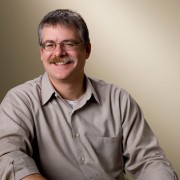
“The whole premise is if you’re going to attract 12,000 to 15,000 people for 60 to 70 nights, it has to produce a requirement for hotel rooms and restaurants,” says Jacobs. “It does work, and it’s not necessarily related to the success of the team. If you get people down there, it works. It’s like building a shopping center where the anchor is an arena or ballpark instead of Saks Fifth Avenue.”
Helping assure the steady flow of people to downtown is El Paso’s ace in the hole: Fort Bliss, which has grown by leaps and bounds since the most recent base realignment and closure round by the U.S. Army. Col. Cary Westin serves as vice president of business development for the defense and clean-tech sectors on Bob Cook’s Borderplex Alliance team. He says a study released by the University of Texas-El Paso this month shows the base has an annual economic impact of $5.98 billion. The base has added 20,000 soldiers and approximately 40,000 family members over six years.
But in addition to welcoming new brigades, the base also has welcomed the Brigade Modernization Command, which is responsible for testing new technologies from robots to telecom to renewable energy applications in combat situations. At last count, the Army was testing between 50 and 60 additional capabilities. Thus, says Cook, “a lot of high-tech companies are looking at the region, and quality-of-life amenities such as the ballpark will be a big deal as to whether those companies make an investment.”
When those prospects visit, they might encounter Hunt Companies, which started in the 1940s as a lumber company and has since made a national splash with its excellence in multifamily and military residential and commercial development, among other specialties. The involvement of CEO Woody Hunt and Senior Vice President Josh Hunt in the MountainStar Sports Group says a lot, according to Jacobs.
“These are very smart real estate people,” says Jacobs. “If they say this is what downtown El Paso needs, you put more stock in it than some guy who says, ‘I love baseball.’ They bought the baseball team to help their city. You don’t find that a lot. They live in El Paso and they built their company there. Their opinion is to be valued more than just a guy who owns a baseball team.
“It also shows there are cities that can get things done, and cities that can’t get these things done, that don’t attract teams or build arenas,” he continues. “The reasons may be good, but people say, ‘Why would they let that team leave?’ Denver built three major professional sports facilities in a decade. So Denver gets a reputation of getting things done, and I think that’s an important message.”
Minor league baseball isn’t new to El Paso. A stadium some 10 miles from downtown has been home to the Double-A franchise of the Milwaukee Brewers and then the Arizona Diamondbacks, and most recently to a team in the maverick Independent League. But El Paso’s ascension to the ranks of the 30 Triple-A communities serving Major League Baseball’s 30 teams is significant when it comes to other economic development activity.
“There is a wonderful, wonderful, contagious affiliation that comes to El Paso with baseball,” said Pacific Coast League President Branch Rickey in announcing the team acquisition in October. In comments reported by the El Paso Times (whose building is also making way for redevelopment), Rickey added, “As your city’s name is mentioned in the (sports news) coverage, you are identified with other member teams in the league — teams whose stature draw attention to what El Paso has become in recent years.”
Paul Jacobs recalls a conversation from when he was leading the charge to get the Rockies and Coors Field in Denver.
“I got a call from a very senior VP type at United Airlines,” he says. “It was at the same time Denver was trying to get a maintenance facility for United. It ultimately went to Indianapolis. But the guy said, ‘It’s really important to us to know what the sports landscape is. What are your chances of getting the team?’ I thought, ‘Wow, here’s a big company thinking of putting a major facility in Denver, and it’s important to them.’ Our economic development people also think it’s very important. Having a Major League Baseball team in our city, that’s what makes it a ‘major league city.’ In El Paso, to say “Triple-A city” is meaningful to them.”
Cook corroborates Jacobs’ experience.
“Now that we’ve announced a baseball team, its fun when sitting in boardrooms with prospects, because we see a positive visceral reaction. It shows that, first, El Paso has stepped up and made a significant commitment, and two, we’re doing significant quality-of-life things” because of the bond package. “The sentiment being expressed by the citizens is ‘We’re making an investment in our future.’ Things are really good in El Paso right now.”
Josh Hunt says he’s seen how it can work in places such as Durham, N.C.; Denver; San Diego; Tulsa; and Oklahoma City.
“In all those cases, creating sports facilities is bringing people downtown, and also helpful in recruiting businesses,” he says. “I believe every great city has a great downtown. We think this project and others under way will go a long way for us to have a great downtown this community deserves.”
For continuing coverage of baseball’s arrival in downtown El Paso, follow the comprehensive reporting of the El Paso Times.
